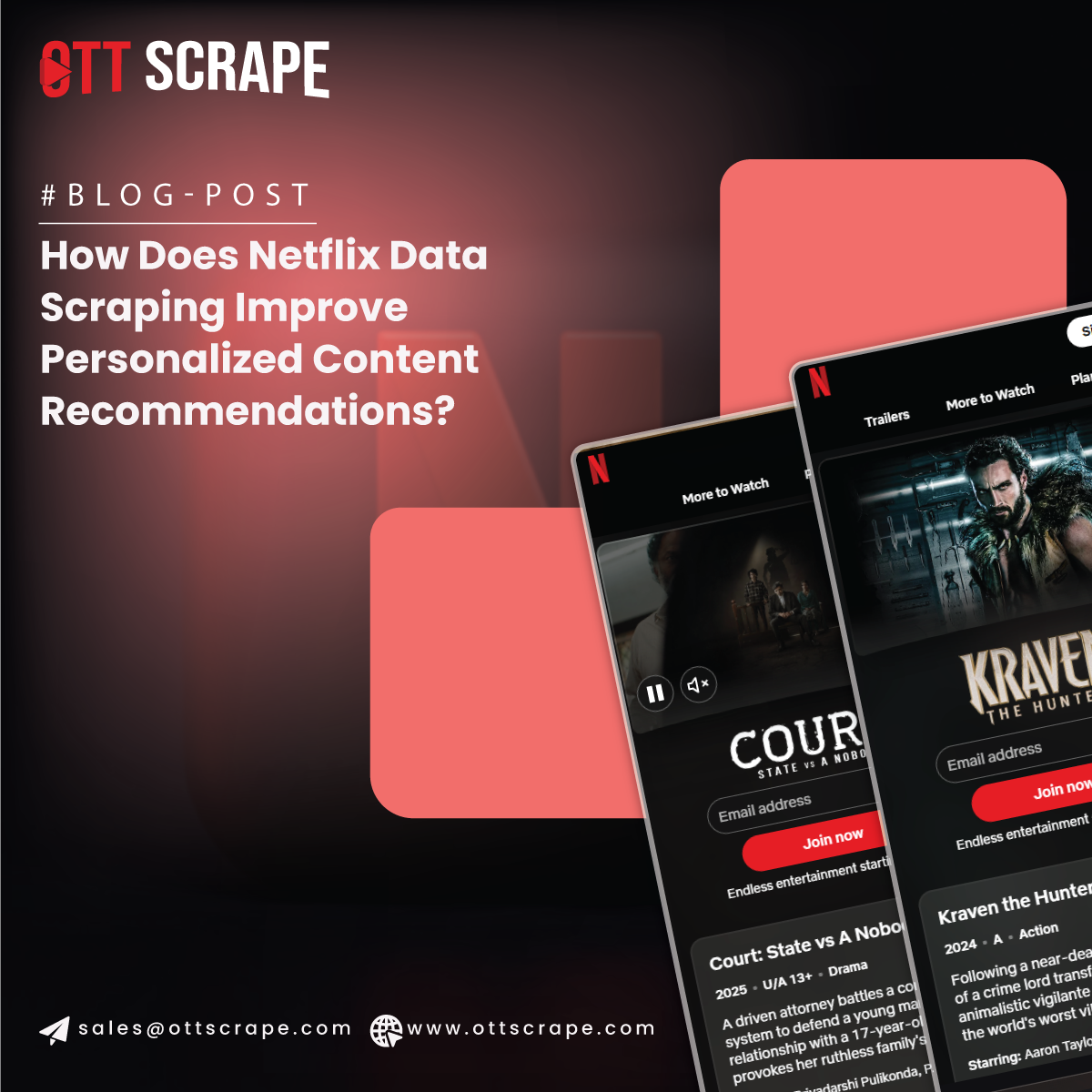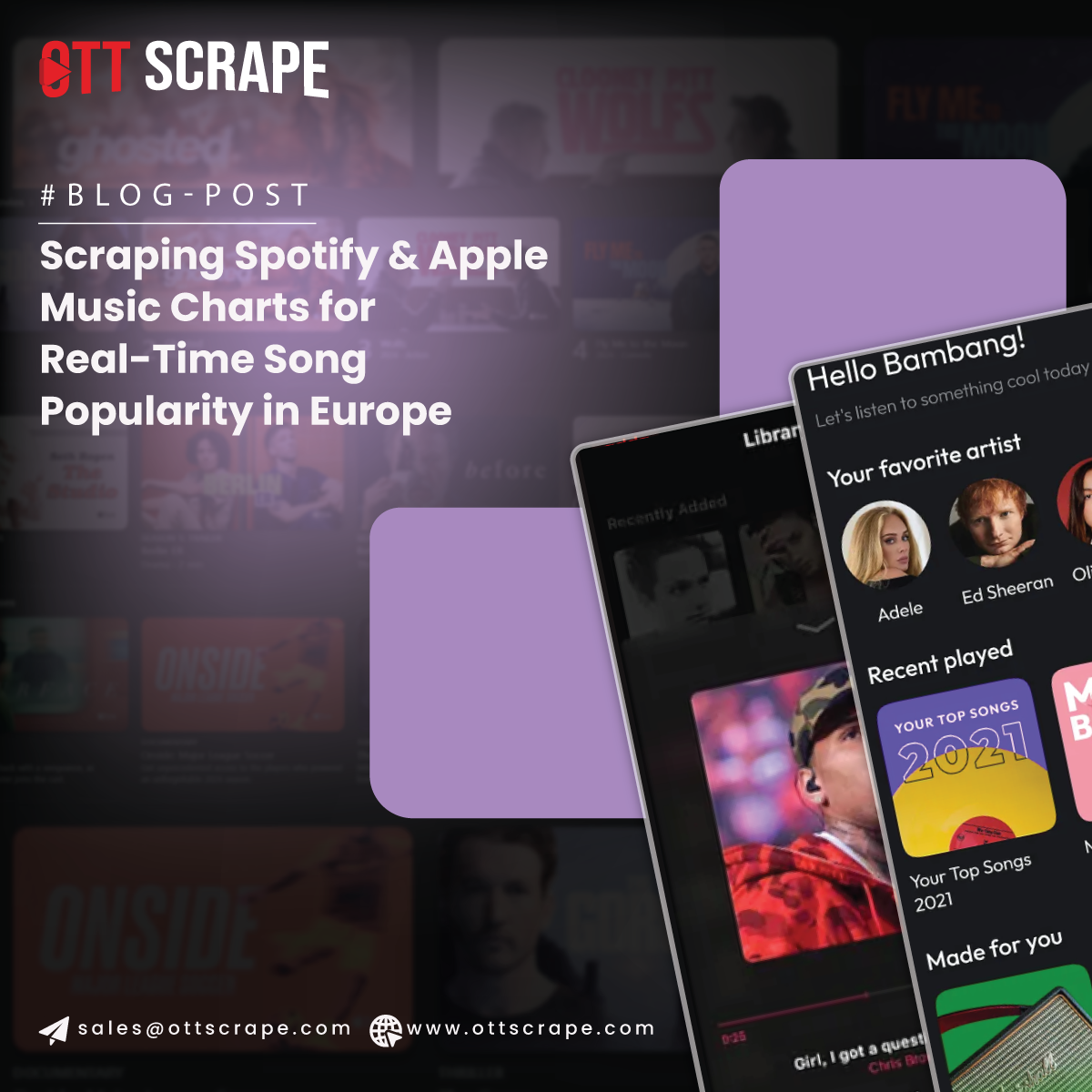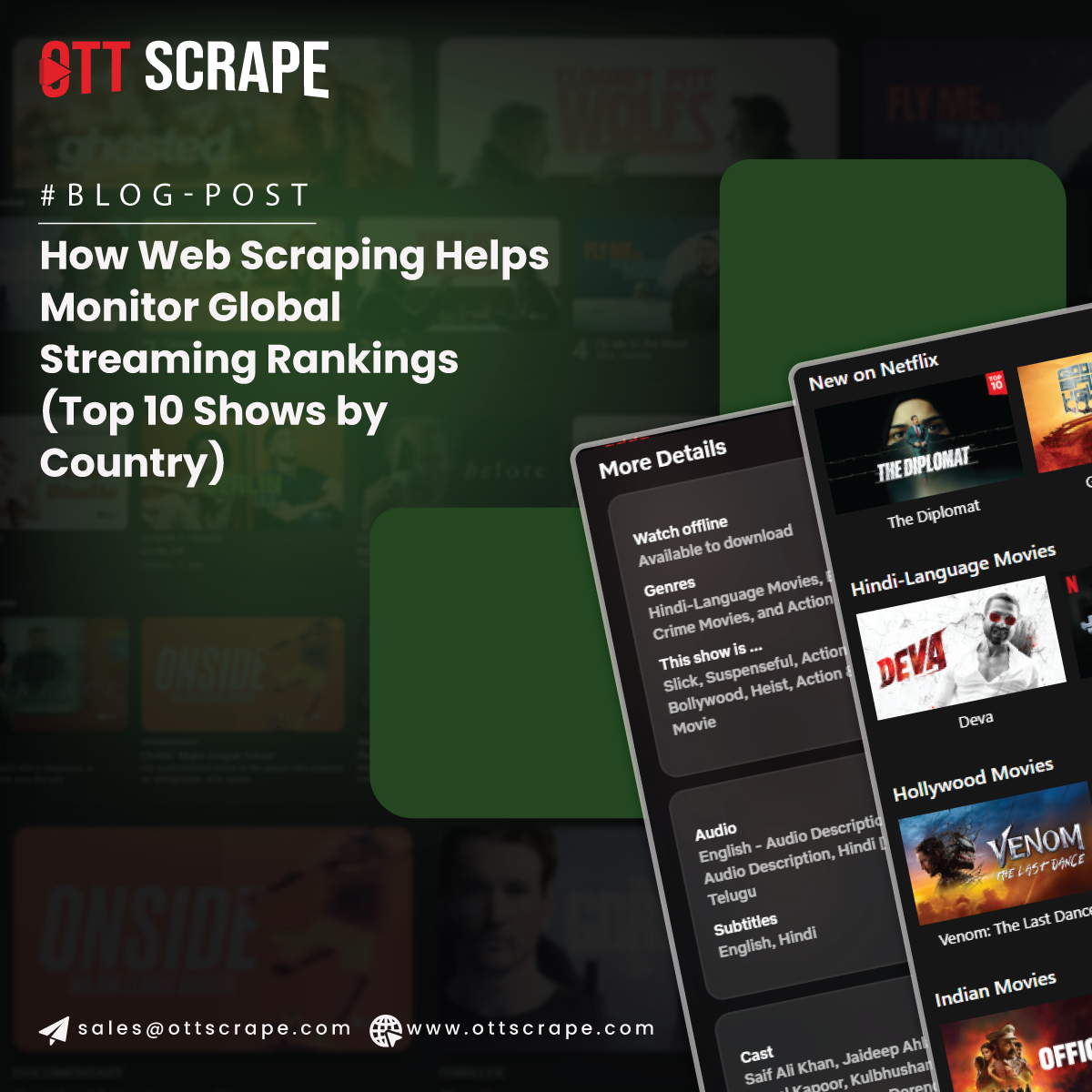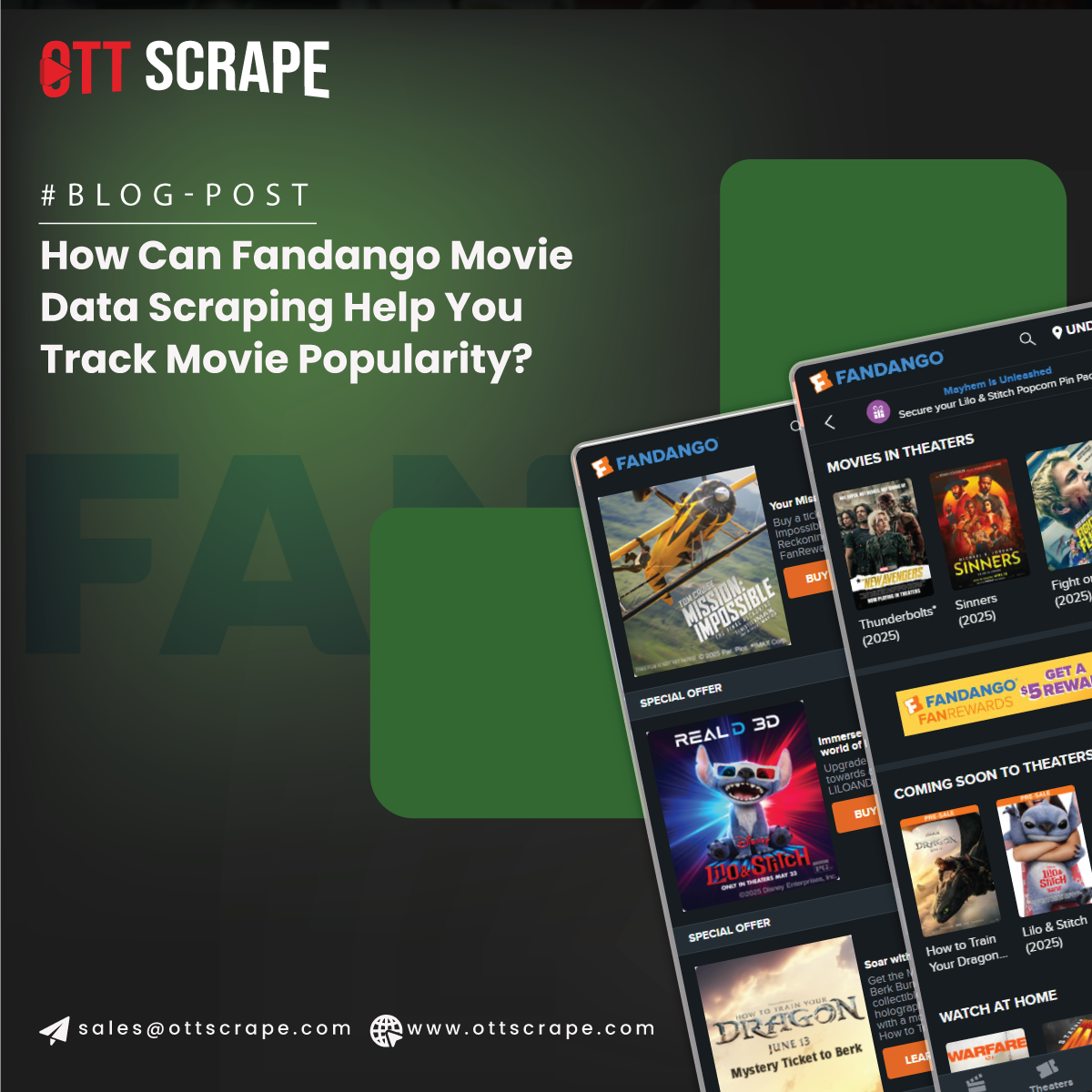 Infographics for Backlinks – Visual Goldmines for Authority Sites!
Infographics for Backlinks – Visual Goldmines for Authority Sites!
Best Ways to Scrape Real-Time Streaming Data from OTT Platforms with Python
Written by ott scrape » Updated on: October 11th, 2024

What Are the Best Ways to Scrape Real-Time Streaming Data with Python
Introduction
In today's data-driven world, scraping real-time streaming data with Python is crucial in the entertainment industry. It enables businesses to gather continuous, up-to-date information about viewer habits, content performance, and emerging trends. Being able to scrape real- time streaming data with Python allows organizations to capture and process dynamic data efficiently. Whether analyzing viewer ratings or tracking new releases, scraping streaming data helps businesses stay agile and responsive. This article will explore how to effectively collect streaming data from OTT platforms, covering essential tools, libraries, and techniques. By implementing these methods, you can unlock deeper insights and make real- time adjustments based on constantly updating information, giving your organization a competitive edge in today's fast-paced entertainment environment.
Understanding Real-Time Streaming Data in OTT
Understanding-Real-Time-Streaming-Data-in-OTT
Real-time streaming data in the context of OTT platforms refers to continuously generated and delivered information about user interactions, content performance, and other metrics that impact viewing habits. Unlike static data, which is collected at specific intervals, streaming data is dynamic and constantly changing, making it highly valuable for businesses that need up-to-the-minute insights for timely decision-making. Capturing and processing real-time data from OTT services requires specialized techniques beyond traditional data collection methods. The real-time nature of the data presents challenges such as handling high volumes of incoming data, ensuring low-latency processing, and maintaining accuracy. Efficient scraping of this data involves using advanced tools and methodologies to collect, process continuously, and store information as it arrives. Mastering these techniques allows businesses to stay agile and respond quickly to trends, viewer behavior, or market shifts, providing them a competitive edge in the fast-evolving digital entertainment landscape.
Why Scrape Real-Time Streaming Data from OTT Platforms?
Why-Scrape-Real-Time-Streaming-Data-from-OTT-Platforms
Real-time data streaming with Python scraping from OTT platforms is crucial for businesses aiming to stay competitive in the entertainment sector. It enables companies to gain immediate insights, track evolving viewer trends, and respond quickly to changes in the market. By implementing real-time streaming data Scraping, organizations can effectively monitor and analyze continuously updating data from various sources, including viewer interactions, ratings, and content performance.
Timeliness: The ability to access and process data instantly allows businesses to make informed, real-time decisions. With real-time streaming data collection, companies no longer rely on outdated information, enabling swift reactions to market shifts or emerging opportunities.
Trend Analysis: Using real-time streaming data Scraping Services, organizations can identify viewing trends as they develop, giving them a competitive edge. By continuously monitoring the latest data, businesses can predict future viewer behaviors, tailor content strategies, and stay ahead of competitors.
Enhanced Customer Engagement: Web Scraping real-time streaming data empowers businesses to react instantly to viewer feedback and behavior. By leveraging these insights, companies can make personalized adjustments to their content offerings, improving overall viewer satisfaction and experience.
Essential Python Libraries for Scraping Streaming Data
Essential-Python-Libraries-for-Scraping-Streaming-Data
To Extract real-time streaming data from OTT platforms, Python offers several powerful libraries:
BeautifulSoup : Used for parsing HTML and XML documents, it's excellent for scraping static web pages.
Requests : Allows you to send HTTP requests easily, making it essential for interacting with APIs.
Selenium : Ideal for scraping dynamic websites where data is loaded via JavaScript.
WebSockets : A protocol that provides full-duplex communication channels over a single TCP connection, suitable for real-time data transmission.
Pandas : Essential for data manipulation and analysis.
Step-by-Step Guide to Scraping Real-Time Streaming Data from OTT Platforms
Step 1: Setting Up Your Environment
Before you start real-time streaming data scraping, install Python on your machine. You can install the necessary libraries using pip:
pip install requests beautifulsoup4 pandas
Step 2: Identifying Your Data Source
Determine the source from which you want to scrape data. This could be an API from an OTT platform, a website, or even viewer interaction data from an IoT device.
Step 3: Accessing the API
1. Create an Account with the Data Provider: Register with the provider of the streaming data API to get your API credentials.
2. Get API Credentials: After registering, you will receive credentials, such as an API key, that will allow you to authenticate your requests.
Step 4: Streaming Data Using an API
Streaming-Data-Using -API
Here's a simple example of how to stream data in real time using a generic OTT API. For illustration, we'll use the Requests library to connect to the API.
Step 5: Analyzing the Data
Analyzing-the-Data
Once you have collected the data using real-time streaming data scraping services, you can perform various analyses, such as trend detection, statistical analysis, or visualizing the data using libraries like Matplotlib or Seaborn.
Best Practices for Scraping Real-Time Streaming Data
Best-Practices-for-Scraping-Real-Time-Streaming-Data
Efficiently real-time streaming data Extraction from OTT platforms requires adherence to best practices to ensure data accuracy, performance, and compliance. Following essential guidelines, businesses can optimize their real-time streaming data extraction process, manage large data volumes, and extract valuable insights while maintaining data integrity.
Respect Rate Limits: Always adhere to the API's rate limits to avoid being blocked or restricted by the data provider. Each API has specific limitations on how many requests can be made within a given time frame.
Implement Error Handling: Real-time data scraping can be prone to issues such as network failures, API changes, or timeouts. Therefore, implementing robust error-handling mechanisms is essential to ensure the stability of your scraping system.
Monitor Data Quality: Continuously verify the quality and integrity of the scraped data, including:checking for missing or corrupted data,ensuring that the information is correctly formatted, andstoring backups regularly.
Optimize Performance: Performance optimization is critical to ensuring efficiency when dealing with large volumes of streaming data. Consider using: asynchronous programming, multi-threading, or parallel processing to manage multiple data streams simultaneously.
Conclusion
Scraping real-time streaming data from OTT platforms with Python opens up numerous possibilities for analysis and insights. By leveraging the correct libraries and understanding your data source, you can effectively gather and analyze dynamic information.
Whether tracking viewer trends, monitoring content performance, or collecting data from user interactions, Python provides a robust framework for real-time data scraping needs in the competitive landscape of OTT streaming.
Embrace the potential of OTT Scrape to unlock these insights and stay ahead in the competitive world of streaming!
#ScrapeRealTimeStreamingData
#RealTimeStreamingDataScraping
#RealTimeStreamingDataScraper
#RealTimeStreamingDataCollection
#RealTimeStreamingDataExtraction
#ExtractRealTimeStreamingData
#RealTimeStreamingDataScrapingServices
#WebScrapingRealTimeStreamingData
#RealTimeStreamingDataKPI
Note: IndiBlogHub features both user-submitted and editorial content. We do not verify third-party contributions. Read our Disclaimer and Privacy Policyfor details.
Copyright © 2019-2025 IndiBlogHub.com. All rights reserved. Hosted on DigitalOcean for fast, reliable performance.














